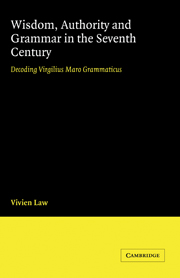Book contents
- Frontmatter
- Contents
- Preface
- Abbreviations
- Introduction
- 1 The outer layers: parody and word-play
- 2 The wisdom tradition
- 3 Avarice and the four keys to wisdom
- 4 The multifarious nature of wisdom
- 5 Heretical knowledge? The constitution of man
- 6 The Epistolae: Virgilius' Retractatio?
- 7 Concealment of mysteries: the techniques of secrecy
- 8 Virgilius and the seventh century
- 9 Conclusion
- Appendix 1 Epistola II 14-93: The vocative of ego
- Appendix 2 Epitome XV: The catalogue of grammarians
- Notes
- Works cited
- Index
Appendix 1 - Epistola II 14-93: The vocative of ego
Published online by Cambridge University Press: 10 November 2009
- Frontmatter
- Contents
- Preface
- Abbreviations
- Introduction
- 1 The outer layers: parody and word-play
- 2 The wisdom tradition
- 3 Avarice and the four keys to wisdom
- 4 The multifarious nature of wisdom
- 5 Heretical knowledge? The constitution of man
- 6 The Epistolae: Virgilius' Retractatio?
- 7 Concealment of mysteries: the techniques of secrecy
- 8 Virgilius and the seventh century
- 9 Conclusion
- Appendix 1 Epistola II 14-93: The vocative of ego
- Appendix 2 Epitome XV: The catalogue of grammarians
- Notes
- Works cited
- Index
Summary
The first pronoun to be discussed is the finite pronoun ego, ‘I’, on which so many people raise countless questions, looking into how and why one and the same pronoun is made up of such dissimilar letters, e.g. ego mei ‘I, mine’. Many people have wanted to calm the dispute with erudition, affirming that ego ‘I’ should always be considered an uninflected noun, so that in every number, gender and case one should use ego alone. Terrentius believed that ego should be judged to be among the defectives, so that apart from the nominative it has no case. Nonetheless, they agreed in a joint exhortation and definitive pronouncement that mius should be used for ego and is to be declined thus: mius, mei or mis, mihi, o, a me. Galbungus' followers, objecting from their contrary stance, said: ‘If this is the case, why is this sequence of letters not also observed in the plural, where we say nos nostrum?. In any case there are quite a large number of words which, although they do not retain the same sequence of letters, nonetheless indubitably agree in sense and meaning. Hence, this pronoun is to be defended on similar grounds, namely, that it is correctly declined in the way that most people observe — ego mei, and in the plural nos nostrum.’
When I relayed this question to my Aeneas, we spent the better part of a day pondering this at length.
- Type
- Chapter
- Information
- Wisdom, Authority and Grammar in the Seventh CenturyDecoding Virgilius Maro Grammaticus, pp. 109 - 111Publisher: Cambridge University PressPrint publication year: 1995

